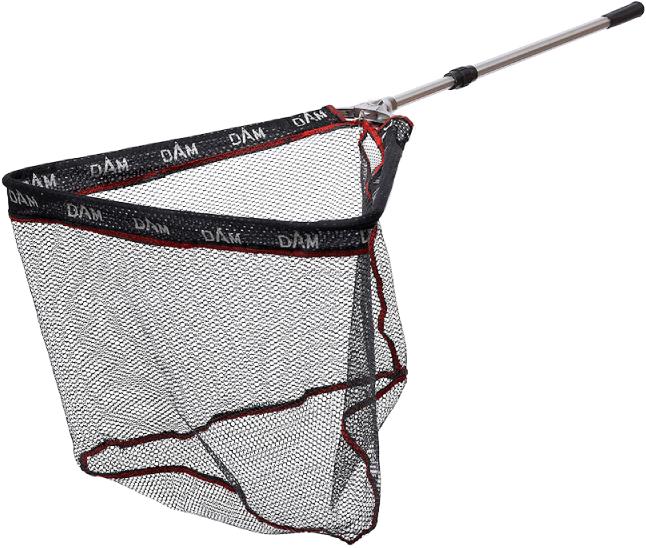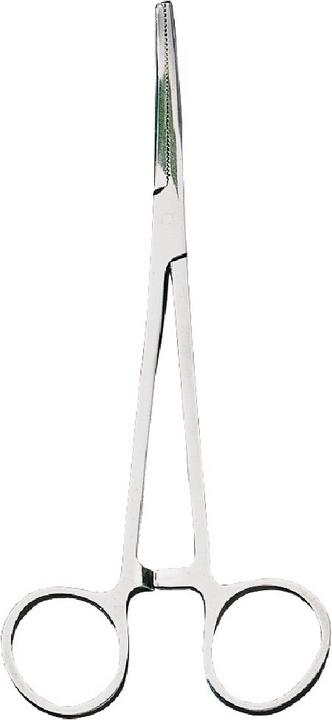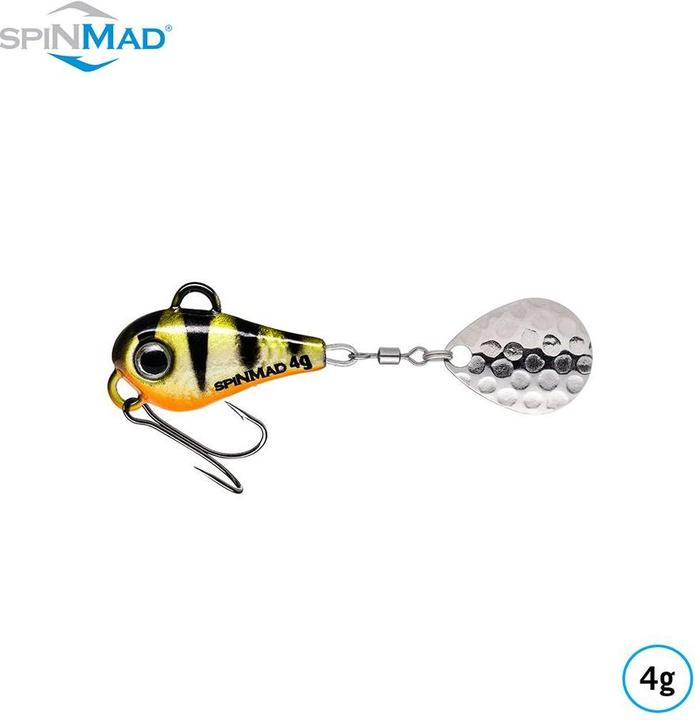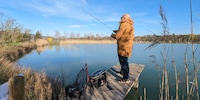
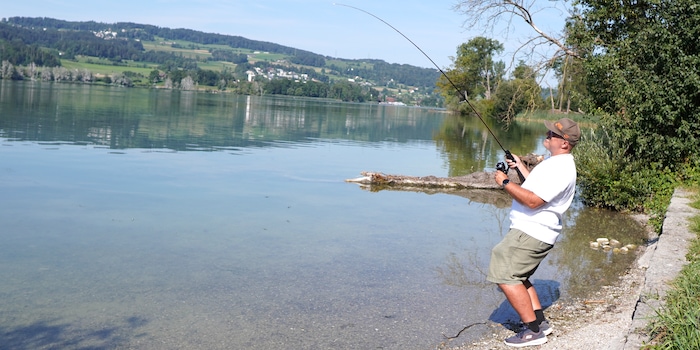
How this Swiss-made fishing tackle guarantees you a bite
Zurich-based company Jaeger Fishing promises you’re guaranteed to hook a perch with one of its complete sets. Let’s see if I can really catch a fish with mine.
The blazing sun is beginning to burn up the last of my patience. I cast and cast and cast again, but the fish aren’t biting. Suddenly, I feel the line jerk... but more on that later. First, let’s have a look at my sample kit.
Swiss fishing brand Jaeger promises you can simply unpack your gear, get started and reel in the fish. The Zurich-based start-up has put together some special sets to make this possible, including a rod, reel, line and even lures. There’s also an instructional manual for beginners.

Just a heads-up: in Switzerland, you need a fishing permit to angle for predatory fish. So before you go out and cast your rod, make sure you know what the regulations are.
All kitted out for my first cast
Time to unpack the Jaeger Fishing box. I’ve been given the Basic kit to review. For just under 100 francs, you get not just a rod and reel, but also a pack of lures and a pre-assembled Carolina rig. What’s that, I hear you ask? More on that later.
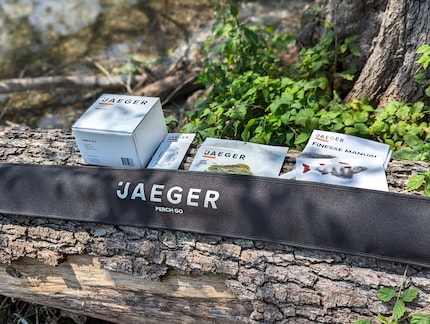
Source: Lorenz Keller
I start off by looking at the instructions before slotting the two-piece rod together and screwing on the reel. Fortunately, it’s a pre-spooled reel, so the line has already been wound onto it. All I have to do is thread the line through the rings on the rod and tie on the Carolina rig. It’s all explained in a way that allows even beginners to understand it. Then, I just have to put on the rubber lure and I’m ready for the first cast.
The whole process barely takes ten minutes. Jaegar’s ready-to-go kit is the main advantage, as it saves you a lot of time – especially if it’s your first attempt. As the name suggests, the Perch Go Kit
is designed for catching perch. In Switzerland, this is the most popular predatory fish, especially among beginner anglers.
However, it’s worth remembering that the kit doesn’t include everything you need for fishing. And depending on where you are, this missing equipment might also be mandatory. There’s no landing net for easily bringing your catch onto dry land. Nor are there any pliers for releasing hooks more easily. The set is also missing a fishing priest and knife, which you’ll need in order to kill larger fish in the humane way described during your SaNa course.
Practice makes perch
I cast for the first time, following the instructions to the letter. The Carolina rig is a weight threaded onto the line, with a see-through bead underneath it. Both components move freely on the line, stopped near the bottom by a small piece of rubber. This is followed by about another half metre of fluorocarbon line, with a hook and lure mounted at the end.
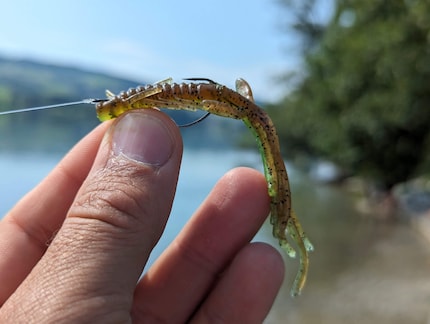
Source: Lorenz Keller
After casting, I let the ten-gramme weight sink all the way to the bottom and wait a few seconds. After that, I give the rod a quick jerk and spin the reel two or three times. I wait for the weight to hit the bottom again.
What’s happening under the water? The weight bounces up, then quickly sinks back to the bottom, hitting the bead as it does so. This makes a clacking noise, which attracts fish. The lure also springs up at first, before sinking much more slowly than the weight attached to the line. This causes it to tumble to the bottom, a movement that mimics an injured prey animal. As a result, predators are enticed into taking a bite.
Beginners will need a little practice to get the hang of this technique. The Jaeger Perch Go Kit is good for this, as this is exactly the sort of fishing it’s designed for. Simply put, the rod is good enough for you to be able to feel the weight hitting the bottom each time with a soft thunk.
The tricky thing when you’re just starting out, however, is that this feels pretty similar to getting a bite. It’s a kind of tugging sensation, often happening in quick succession. But wait, something really was just pulling at the line...
I’ve landed my first fish – but I haven’t achieved my goal just yet
When I gently lift the rod, there is in fact a fish dangling from the hook. I’d had the lure right in front of me for a few seconds in maybe 50 centimetres of water. And a bass had taken the bait.
Not the perch I’d intended to catch, but a sunfish. Originally from North America, this beauty of a fish has become widespread in Switzerland, and is considered an invasive species.
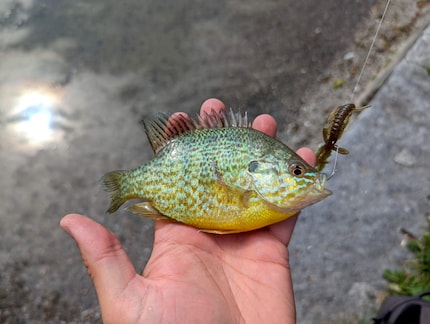
Source: Lorenz Keller
So I’ve now caught my first fish using the beginner’s set. And it’s taken me the best part of an hour. Still no perch, though. I guess that’s why it’s called «fishing» and not «catching». If it’s quick wins you’re looking for, fishing isn’t the hobby for you. It requires patience and perseverance –
something I’m about to learn for myself. As a matter of fact, not a single thing happens for the next two hours. Sure, as someone with a little more experience under my belt, I’m aware it’s sometimes difficult to catch predatory fish early on a summer afternoon. For the purposes of my review, however, I’m imitating a beginner who’s just pitched up at a lake to try it out.
Fish number two is a big surprise
Carolina rigs (also known as a C-rigs), are mainly used to catch fish near the bed of the lake. This is often where you’ll find perch in spring, autumn and winter. In summer, the fish often hunt in the middle of the water column or even at the surface. But even during the summer months, you’ll always find perch at the bottom of lakes.
You learn this sort of thing over time, allowing you to adapt your fishing technique to the situation (which often changes on a day-to-day basis). I crack on with the method suggested by Jaeger. Perseverance makes perfect sense for beginners. Instead of changing bait every five minutes, be patient and build your confidence.
When fishing near the lake bed, the weight or the lure will get caught on weeds every now and again. This is often inevitable, especially near the shore. It happens to me, too. There’s a quick jerk as something attaches itself to the line.
I reel it in, only to find not just greenery hanging from the Carolina rig, but a small pike. Blimey! Thankfully, I have a landing net and pliers handy, as these predatory fish have sharp teeth. As a result, I can unhook it and drop it right back in the water without touching it.
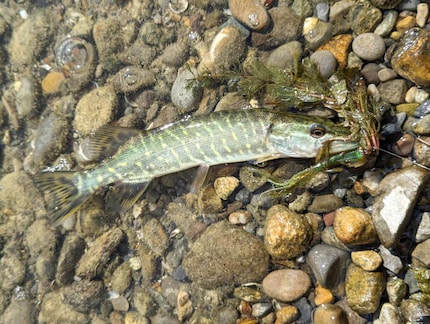
Source: Lorenz Keller
Third time lucky?
After almost four hours, it finally happens. Just as I’m lowering the Carolina rig again, I feel a brief vibration. It’s a bite! I pull up on the rod, revealing a perch dangling from the end of it. I get a rush of adrenaline. Feeling chuffed, I land the fish. Even if the perch is really small, it’s mission accomplished.
The Jaeger Perch Go Kit has come up with the goods, and it’s managed it in less-than-ideal conditions. Testing the set in these circumstances, however, made things much more realistic. After all, beginner anglers don’t yet have a knack for adapting to different situations. Even for someone like me, with a little more know-how, it was definitely a learning experience to see how persisting with a particular method can be worthwhile.
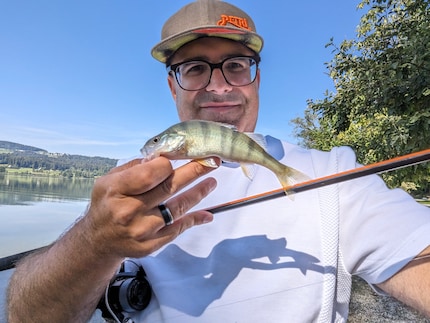
Source: Lorenz Keller
Praise and criticism for the Swiss-made beginner’s set
I would’ve liked a starter set like this when I passed the SaNa exam just over three years ago: a rod, reel, line and lure all focused on and tailored to a target fish. Instead, like many other beginners, I opted for an inexpensive all-around rod – a jack-of-all trades and a master at none. It’s now lying in my basement.
When fishing for that oh-so-popular perch, you need a combo that reliably transfers the sensation of gentle bites and subtle activity around the lure. In other words, you need to be able to feel biting, tugging and jerking across both the line and the rod. Despite its low price, the Perch Go Kit fulfils this important requirement.
Alternatively, you could use those 100 francs to put together a suitable set containing a 50-franc rod and a 50-franc reel. However, you’ll need to do a fair bit of research and get good advice if you want to achieve the same level of quality.
Jaeger gives you a set that’s been well matched to a target fish, and provides good value for money. The line and lures are basically a free extra. Everything’s ready to go, allowing you to get started quickly.
That being said, using the C-rig would be unusual for someone looking to catch their first fish. Beginners often start out with a jig spinner or spinner. You can just cast them out, let them sink and steadily reel them in. Since Jaeger Fishing explains everything well and takes the most difficult part of the Carolina rig (tying the mount) off your hands, this method is also very beginner-friendly.
Verdict: Jaeger has successfully reeled me in
What sets the Perch Go Kit apart from other combos is the concept behind it. Instead of just getting a reel and rod, you get everything matched and ready to go. The instruction manual covering all the basics is a central part of this.
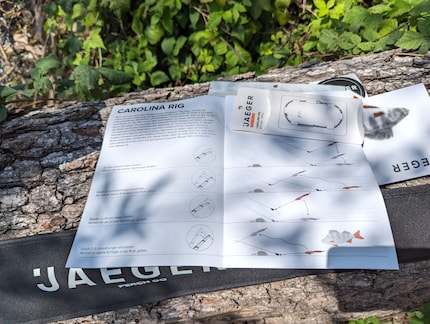
Source: Lorenz Keller
Of course, I can’t expect miracles at this price. My own combo, which cost 350 francs, is better quality and offers more feedback. But the Swiss-made set is good enough that I, someone with a little more experience, enjoy fishing with it. It’s also of far better quality than the sometimes even cheaper beginner sets you get in discount stores.
This means the Perch Go Kit isn’t only suited to people who’re new to fishing. It’s also for anglers looking to buy a rod specifically to catch perch. Incidentally, as well as the Basic Edition, Jaeger also has a Performer Edition and a Master Edition. The rod, reel, line and everything else are exactly the same as the ones in the Basic set. You just get more accessories and lures.
Header image: Lorenz Keller
Gadgets are my passion - whether you need them for the home office, for the household, for sport and pleasure or for the smart home. Or, of course, for the big hobby next to the family, namely fishing.
